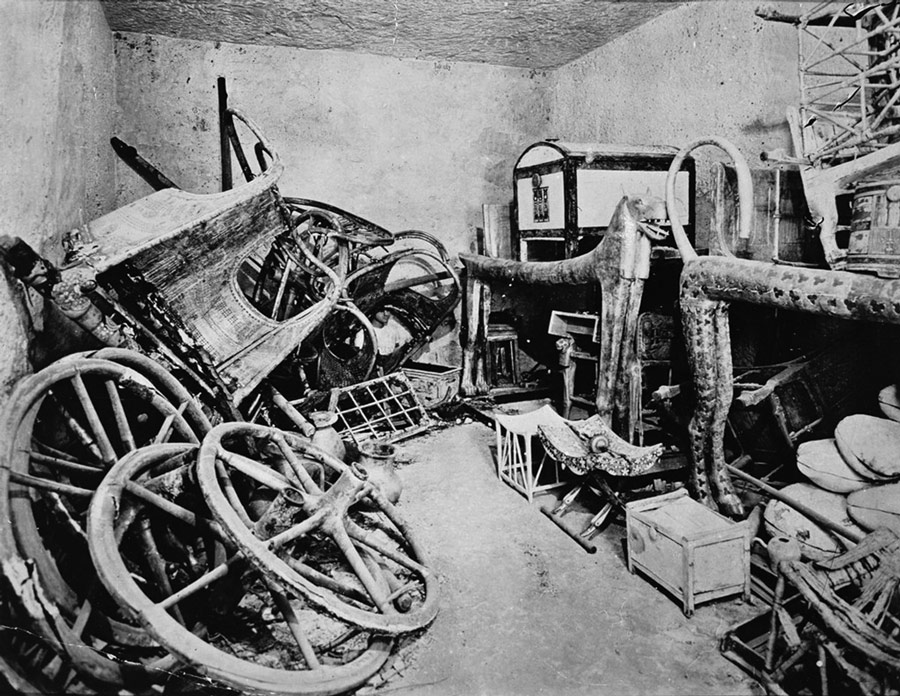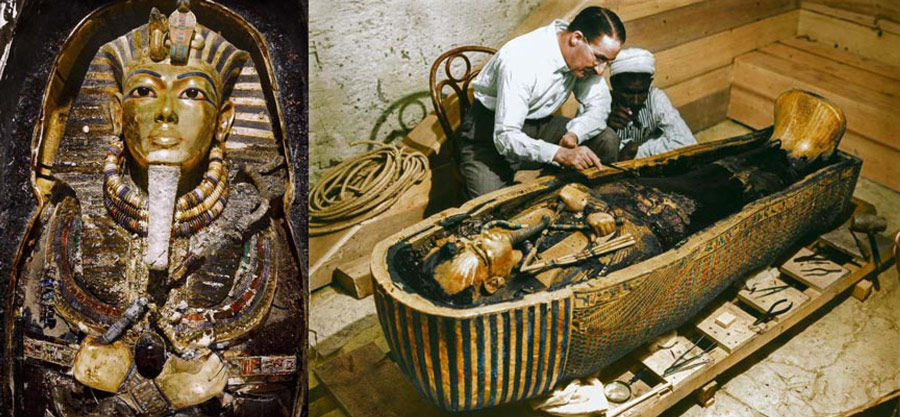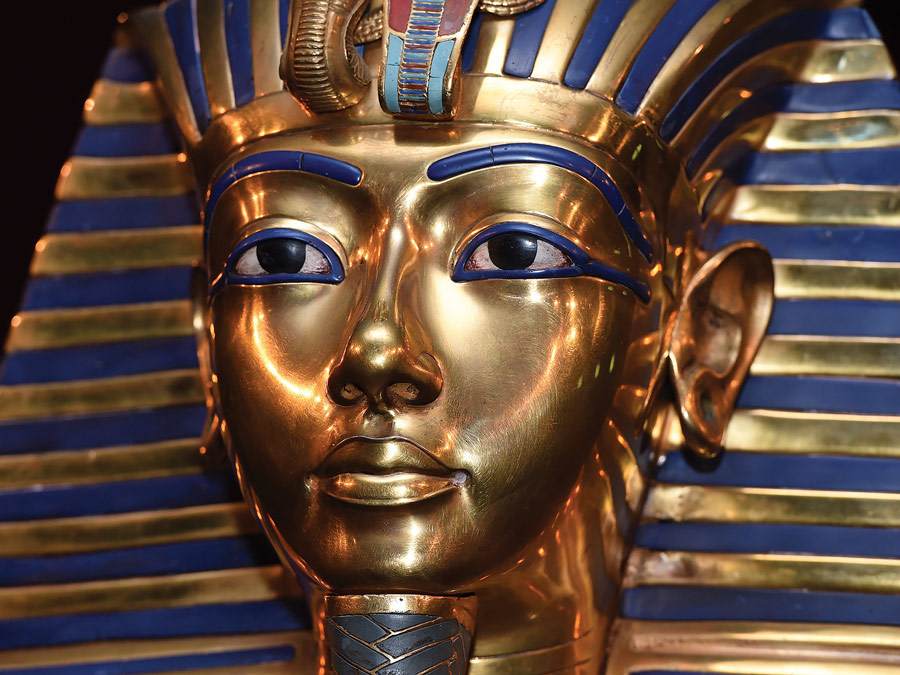Tutankhamun or King Tut is one of the most famous Egyptian Pharaohs, probably because his tomb was discovered by archaeologists. Since then, his remains have held people across the world in awe over the mystery surrounding his life and death. Before the spectacular discovery of his intact tomb in November 1922, Tutankhamun was a little-known figure.
FACTS:
1. King Tut is the most renowned, most studied Ancient Egyptian pharaoh ever to exist.
2. Tutankhamun the sun of Akhenaten and was born in the year 1346BC.
3. He ascended to the throne in 1333 BC, at the age of nine or ten.
4. He reigned during the 18th Dynasty when the Egyptian Empire was at its peak.
5. Tutankhamun was born Tutankheten: His father, Akhenaten wanted all Egyptians to worship the one and only sun god, Aten, instead of their chief deity Amun or any other god. Aten at the end of Akhenaten and Tutankheten signified the same.
6. Tutankheten meaning ‘living image of Aten’ and Akhenaten means the ‘servant of Aten’.
7. When Tutankhamun became Pharaoh he reversed the radicalism of his father and reinstated traditional religious beliefs back to the people. He reopened the closed temples, restored the god Amun to his former glory and moved the capital back to Thebes. He even changed his name to Tutankhamun, which means the ‘living image of Amun’.
8. Tutankhamun CAT scans done on his body revealed he was slight of build, and was roughly 180 cm (5 ft 11 in) tall. He had large front incisors and an overbite characteristic of the Thutmosid royal line to which he belonged, but well nourished..
9. Tutankhamun married one of his half sisters. Her name was Ankhesenpaaten, she was one of Nefertiti’s six daughters.
10. King Tut was nicknamed the boy king as he began ruling just at the age of nine. He was helped to govern the country by his general Horemheb and Aye. Aye would later succeeded Tutankhamun to the throne.
11. There is no evidence of how Tutankhamun met his death. An x-ray done on the mummy found fragments of bones in Tutankhamun’s skull, giving way to a theory that the young king was bludgeoned to death. But more recently, the experts concluded the damage to the skull might have occurred after the death, or at the hands of the crew or during the embalming process.
12. Tutankhamun died at the young age of 18, and his body was mummified, which is how ancient Egyptians preserved their dead. He was buried hastily in the Valley of the Kings tomb, the burial place of his predecessors, surrounded by 5,000 priceless treasures.
13. In spite of his popularity, Tutankhamun’s reign was eradicated soon after his death. Horemheb, the ruler of Egypt after the death of Aye failed to make a huge impact and replaced Tutankhamun’s name with his own on several monuments.
14. Tutankhamun was not buried alone: Apart from the priceless funerary objects, two miniature coffins were also found in the chamber. Researchers suggest that the coffins contained Tutankhamun’s daughter. Tutankhamun and his wife had no children. His wife conceived twice but suffered a miscarriage. The body of the stillborn baby girls were mummified and placed in his tomb in small coffins. Experts also say that Tutankhamun left no living heir, perhaps because he and his wife knew that they could conceive children only with fatal congenital disorders.
15. King Tut’s tomb was buried in such a way that the constellation Orion was above the entrance to the tomb. The Egyptians believed that Orion was the soul of Osiris, the God of Afterlife. It is believed that Osiris continues to watch over King Tutankhamun.
16. Tutankhamun’s tomb was discovered intact by a team of British archaeologists (Howard Carter and Lord Carnarvon) in 1922 that is nearly 3,000 years after his death. The tomb was so well-preserved that the archaeologists were able to get a complete insight of Tutankhamun’s life.
17. The tomb was considered quite small for a Pharaoh king. It contained four rooms, the burial chamber, the antechamber, the annex and the treasury. The first room explored by Carter was the antechamber. It included pieces of four chariots and three funeral beds.

18. The burial chamber contained the most prized items, the sarcophagus and King Tutankhamun’s mummy. The mummy was placed in three nested coffins. The third one was made of gold and had the famous image, which become the symbol of King Tut.
19. The last chamber contained treasures he would need in his afterlife. The ancient Egyptians believed that a person would live in his afterlife the same way he did when he was alive. The treasures in the tomb included a gold crown, canopic jars, paintings, model boats, a golden throne, a cobra, his sandals and big trunks. His sandals had images of his enemies on the soles. So wherever he went, he trampled over his foes.
20. His remains are still contained in his tomb at the Valley Of The Kings, but you can view his burial mask in the Egyptian Museum in Cairo. It will now be moved to the new Grand Egyptian Museum being built located in Giza.
21. The designation given to the tomb at the Valley Of The Kings was KV62; KV stands for the Valley of the Kings and the number 62 was because it was the 62nd tomb found there.
22. It took 17 years for the archaeologist to go through all the items in the tomb.
23. King Tutankhamun’s mask was made of 22 pounds of gold at its size was 54 x 39.3 x 49cm
24. King Tutankhamun’s mask goatee was snapped accidentely by a worker at the museum and glued back on with beeswax, a natural substance that would not damage the precious mask.
25. A protective spell is inscribed with Egyptian hieroglyphs on the back and shoulders of the death mask, in ten vertical and two horizontal lines. It read:
Thy right eye is the night bark (of the sun-god), thy left eye is the day-bark, thy eyebrows are (those of) the Ennead of the Gods, thy forehead is (that of) Anubis, the nape of thy neck is (that of) Horus, thy locks of hair are (those of) Ptah-Sokar. (Thou art) in front of the Osiris (Tutankhamun). He sees thanks to thee, thou guidest him to the goodly ways, thou smitest for him the confederates of Seth so that he may overthrow thine enemies before the Ennead of the Gods in the great Castle of the Prince, which is in Heliopolis … the Osiris, the King of Upper Egypt Nebkheperure [Tutankhamun’s throne-name], deceased, given life by Re.’
26. Tutankhamun’s famous gold death mask was later revealed to have belonged his adopted mother’s – Nefertiti. Her name was found to have been inscribed inside it. To find out more read my novel, Last Secret Chamber.
27. Howard Carter discovered two daggers carefully wrapped inside Tutankhamun’s mummy bandages. One dagger had a gold blade, while the other had a blade made of iron. Each dagger had a gold sheath. Of the two, the iron dagger was by far the more valuable because, during Tutankhamun’s lifetime iron, or “iron from the sky” as it was known, was a rare and precious metal. As its name suggests, Egypt’s “iron from the sky” was almost entirely obtained from meteorites.

28. Two of Tutankhamun’s three coffins were made of wood, covered with gold sheet. But, to Howard Carter’s great surprise, the innermost coffin was made from thick sheets of beaten gold. This coffin measures 1.88m in length, and weighs 110.4kg. If it were to be scrapped today it would be worth well over £1m. But as Tutankhamun’s final resting place it is, of course, priceless.
29. Approximately, 3000 articles were found in the tomb of King Tutankhamun.
30. It was reported than an inscription above the entrance to the burial chamber read: “Death will come to those who disturb the rest of King Tutankhamun”. Some strange events reported to have happened after the discovery of the tomb and removal of treasures from it. In April 1923, just seven weeks after the official opening of the chamber, Carnarvon died due to a mosquito bite on the cheek. It was later found that the Pharaoh had a lesion in the same place on the cheek. At the time of Carnarvon’s death, the light in the city went out, and in his England home, his dog Susie died. Another creepy fact is that Howard’s pet canary was eaten by a cobra on the day of the tomb opening. It was considered as proof of the curse as the cobra is the symbol of Goddess Wadjet, the patron of the kings and queens of Egypt.
Tutankhamun and the mysteries of Egypt have always had a special place in my heart. Using some of the facts from above I created a novel that asks these following questions. Why was the boy Pharaoh buried with his mothers mask? Why hasn’t Nefertiti’s body never been found?
View the Cinematic Book Trailer.

